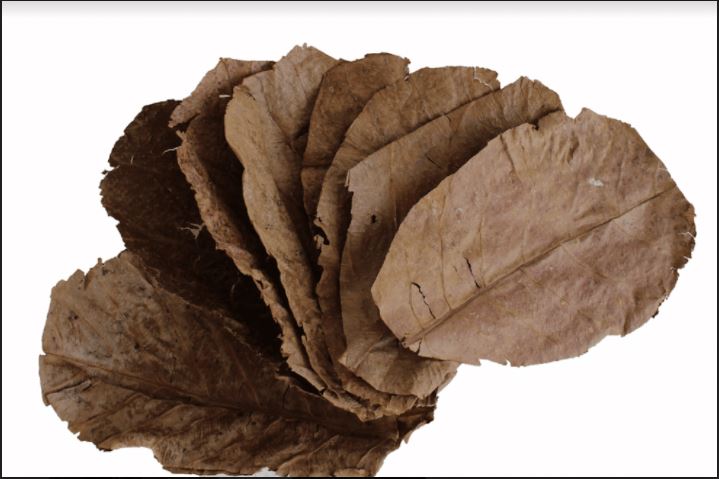Now, it is in trend among aquarists to experiment with botanical leaves and other plant materials to find their usage and benefits in home aquariums and ponds. Indian Almond Leaves is one such botanical leaf popular among the Betta tank owners and the Shrimp keepers.
It is commonly known as Catappa leaves and is native to India, Asia, Australia, Madagascar, and the Pacific; today, it is widespread globally.
It has a significant role in the aquarium trade in the past few decades for its medicinal properties, as an additional source of natural food for newborns and shrimps, to balance the pH of the water, to stain the water to mimic the natural habitat of various fish and shrimp species.
Purpose of Indian Almond Leaves in Aquarium
To know its purpose, we need to know its chemical composition and nutritional values. Alkaloids, Celluloses, flavonoids, Lignins, Pentosans, Saponins, Sterols, Tannins, Triterpenoids, and Ashes are the major chemical composition of Indian almond dried leaves.
Studies indicate that tannins, the chemical components that possess anti-aquatic bacterial property, greatly define water quality.
Anti-bacteria and fungus
Most aquarists recommend Indian almond leaves to fight bacterial and fungus infection to antibiotics and other medications; the usage of Indian almond leaves is not limited to home aquariums and ponds. It is also in practice to use them in commercial fish farms to combat bacteria and fungus. It works like magic for the fish suffering from skin rot disease.
Toughening Betta skin
In Thailand, people breed Betta, also known as Siamese Fighting Fish that can fight for hours though, in nature, the fight lasts a few minutes. These fighter fish breeders use Indian almonds leaves to toughen the Betta skin; though there is scientific evidence supporting this claim, there is a strong anecdote supporting this claim; it is in practice for centuries.
Conditioning aquarium water
It is used for conditioning aquarium water; the acid from the leaves slowly lowers the pH of the water as it seeps into the water. It also helps to reduce the ammonia level in the water by converting ammonia into less toxic substance ammonium, thereby decreasing the burden on the filter.
Food source for fry and the shrimps
They are great for fry tank as it is home to microorganisms collectively known as Infusoria, the first fry food. Shrimps love to munch the leaves and microorganisms present among the dry leaves. In addition, these leaves protect the fry, shrimps, and other shy species.
Spawning mop
Many fish species release their eggs on or underneath broad leaves to protect the eggs from predators and the high currents. Amazonian species such as Tetras release their eggs underneath the leaves; however, species like Bettas build a bubble nest on the surface of the leaves to spawn.
For most fish species to spawn, they need lower pH, precisely what Indian almond leaves offer.
Quarantine tank
In a quarantine tank, it helps to speed up the healing of sick specimens. In the aquarium trade, quarantining the unhealthy fish and newly purchased stock is in practice to avoid the spread of parasites and diseases.
Sometimes, even after the labor, the livebearers, such as guppies, platies, etc., are left to rest in a separate tank to recover. Flavonoids released from Indian almond leaves have anti-inflammatory properties that help to rejuvenate the tired fish.
To stain the aquarium water with tannins:
Staining the aquarium and pond water is the most common usage of Indian almond leaves. Anyone who wants to mimic South American Amazonian waterways or Asian blackwater biotope, Indian almond leaves is a boon.
You can add Indian almond leaves to a tank or pond that requires acidic and soft water. Some of the species that benefit from Indian almond leaves are Bettas, Mollies, Angelfish, Gouramis, Guppies, Platies, Killifish, Tetras, etc.
How do you treat Indian Almond Leaves in Aquarium?

How you add them to your aquarium is depends on the purpose; broadly, there are two methods of adding Indian almond leaves to your aquarium:
Adding Indian Almond Leaves into the tank
The simple and most straightforward method is to drop the leaves into the tank. You can start with one large leaf for every 10-gallon water; to reap the full benefits of Indian almond leaves, you would want to remove the activated carbon and Purigen from your filter; activated carbon and Purigen will absorb the tannins released by the leaves.
It will take few days for the leaves to sink as we are adding only dry leaves. Ensure to monitor your tank water parameters with the test kit every other day.
Adding Indian Almond extractions
Supposing you don’t want to see these giant leaves in your tank, or they might clash with the tank decors, you can obtain most of the benefits by adding Indian Almond Leaves extractions.
To prepare the extraction, boil two quarts (2 liters) of water; in a jar, add a leaf, and pour the boiling water. Let it sit for 24 hours; the liquid will look dark brown; filter the water liquid using a sieve.
You can refrigerate this water in a tight lid jar for several months. Dosage should be an ounce (approx. 30 ml) for every gallon (approx 4 liters) of aquarium water; make sure to add the extraction after every water change.
Final Note
You can adapt the second method to stain the aquarium water, conditioning the water, stimulate spawning, quarantine tank, and also treat anti-fungal and bacterial control. However, you can not use this method when using the leaves as a spawning mop or fry and shrimp tank.




I liked it when you shared that it is great to use Indian Almond leaves in order to remove the activated carbon and Purigen from your filter so your fish can live in a healthy environment. My friend just mentioned the other day that she is planning to get some fish since her son really enjoys looking at the animal that he finds so fascinating. I will suggest to her getting some Indian Almond leaves from a reliable store so she can ensure that the animals are living in a healthy environment.